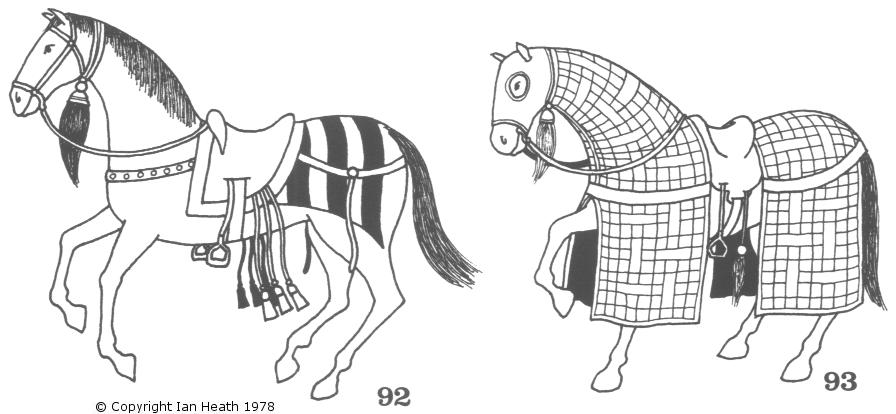
Join Amazon Prime - Watch Thousands of Movies & TV Shows Anytime - Start Free Trial Now
MOSLEM HORSES
An extract from Armies and Enemies of the Crusades 1096-1291by Ian Heath



92 & 93. MOSLEM HORSES
One of the characteristic features of Moslem harness was the collar (Mishadda) worn at the throat, usually with a plume of horse-hair suspended from it as in figure 92. It has even been suggested that this may have been coloured as a means of (unit?) identification. A second plume was often suspended from the breast-strap together with other pendants; 92 has in addition 3 pendants hanging from long straps on either side of the saddle, apparent in many illustrations of Turkish horses throughout this era.
The saddle itself was often very ornate; Usamah describes one as black and quilted, and another as gold with a black centre and the rider's name in black lettering round the edge. The saddle-cloth (Zunnari), which usually covered about half of the horse's back, also tended to be richly decorated.
93, a Seljuk mount dating to c. 1225, is interesting in that it wears a housing, called Kanbush by the Moslems (compare to that of figure 7). These were probably in use by the 12th century and were fairly common by the end of the Ayyubid era. The Mamluk sultan Baibars had a horse with a black housing at his coronation in 1260, and at Acre in 1291 the Templar of Tyre reports of the Mamluks that 'they had their mounted men all armed, and their horses in housings.' At Horns too, in 1281, many of the Mamluk horses appear to have worn housings. Probably the housing sometimes concealed armour.
Horse-armour was in use amongst the Moslems even before the Crusades but owing to the predominance of light cavalry in their armies it appears only rarely in the sources. There were at least 3,000 armoured horses in the Seljuk army defeated at Antioch in 1098, and Sultan Kilij Arslan I rode an armoured horse at the Battle of Khabar in 1107. In his 'Raymond III of Tripolis' M. W. Baldwin even implies that there were armoured horses in Saladin's army at Hattin in 1187, apparently citing Ibn al-Athir and Abu Shamah. Moslem terms for horse-armour were Barasim (bard), Baraki (chanfron) and Tigfaff (quilted armour). The Franks adopted horse-armour in the late-12th century, and its use steadily increased throughout the 13th century; for Frankish horse-armour see figures 120 and 121 in 'Armies of Feudal Europe'.